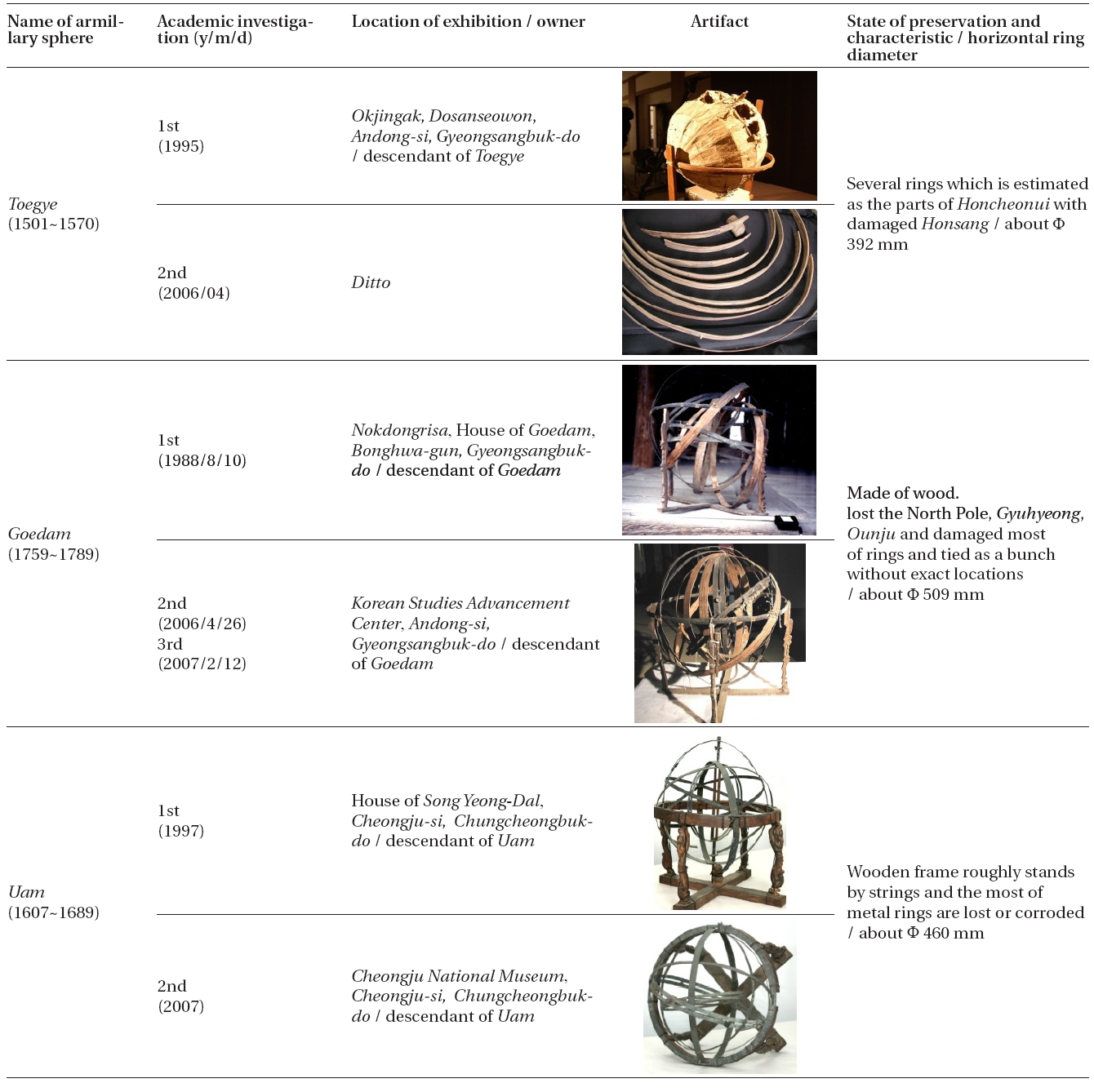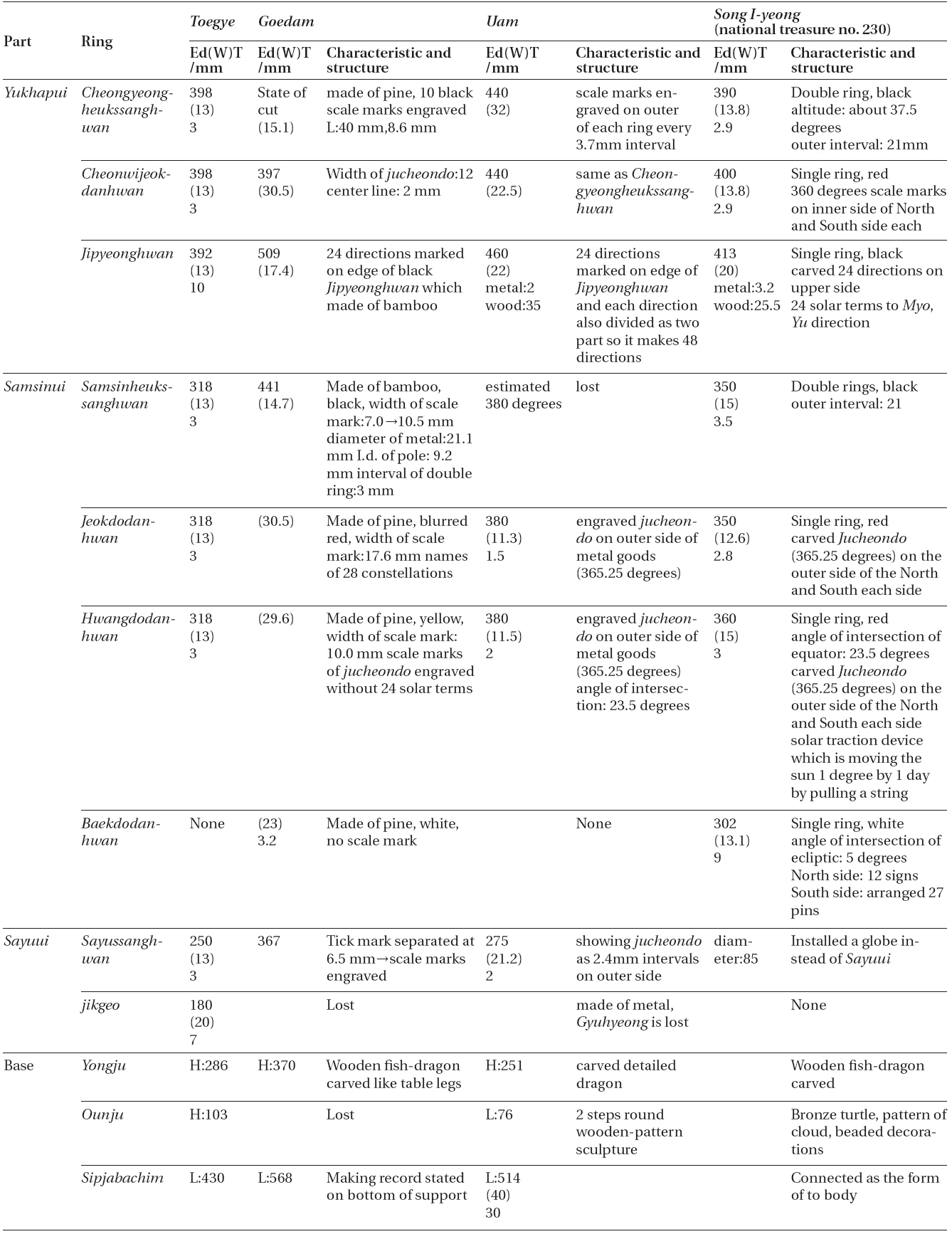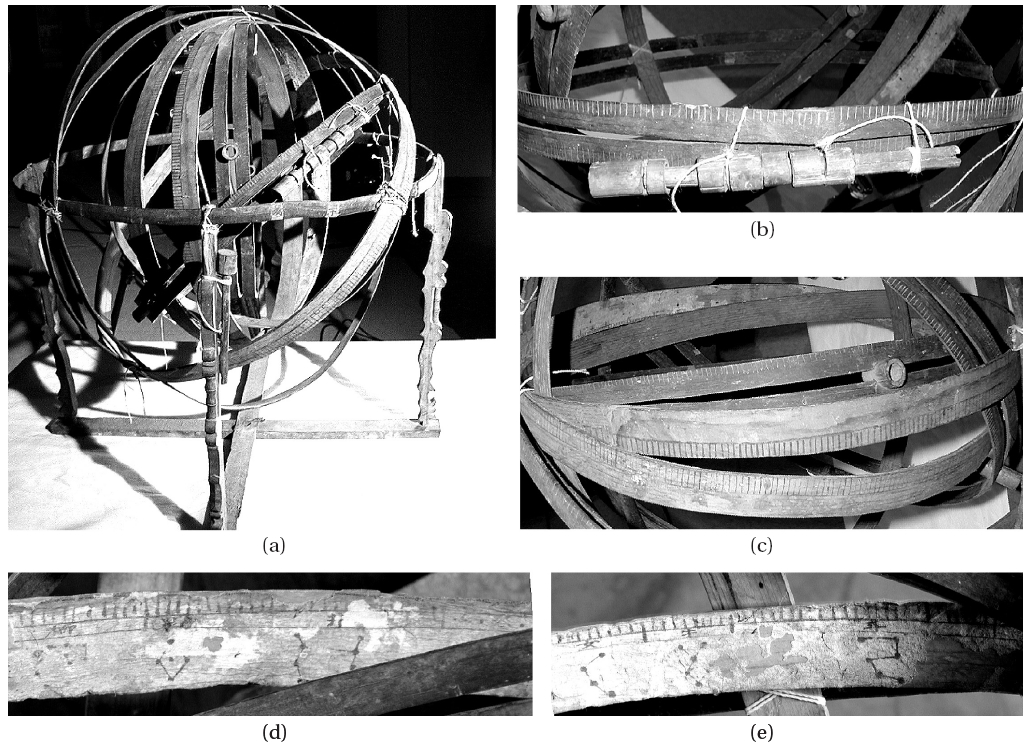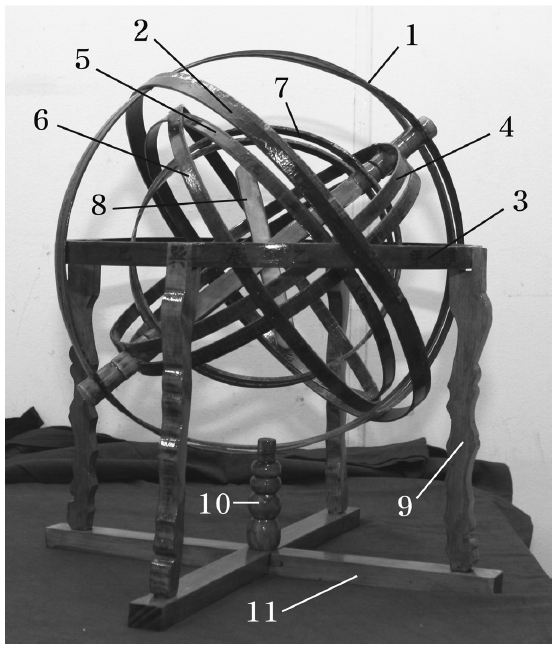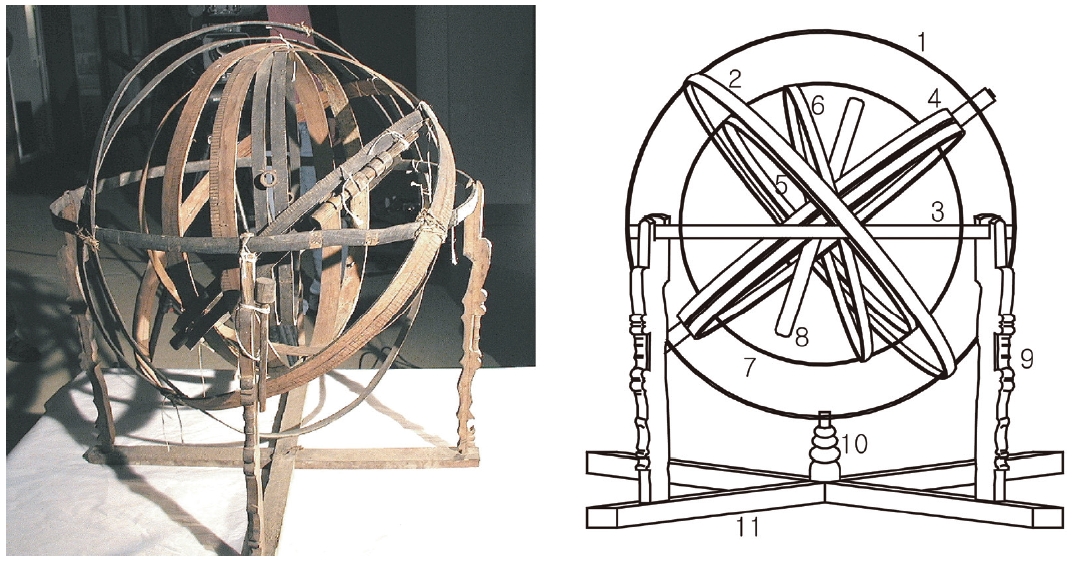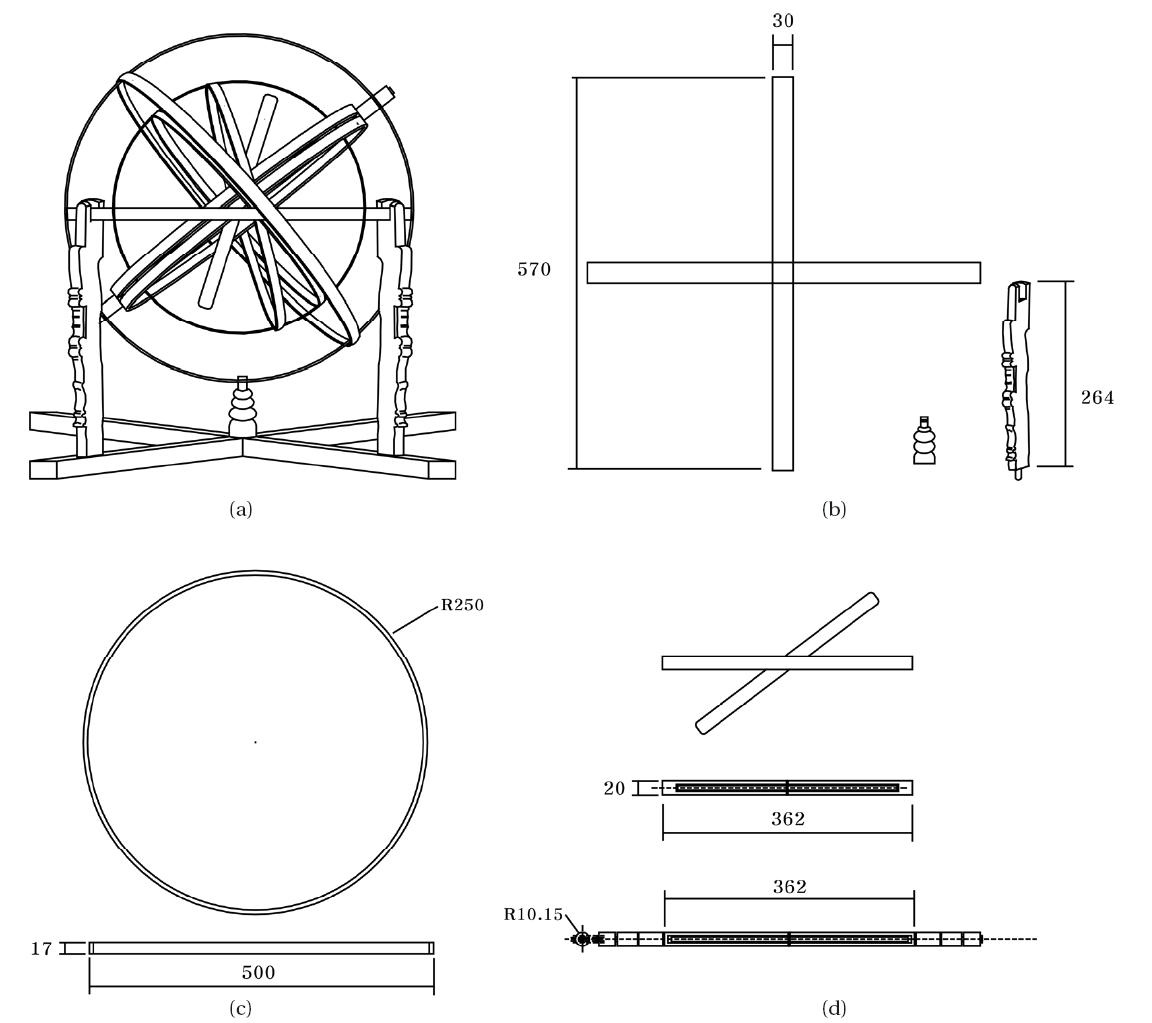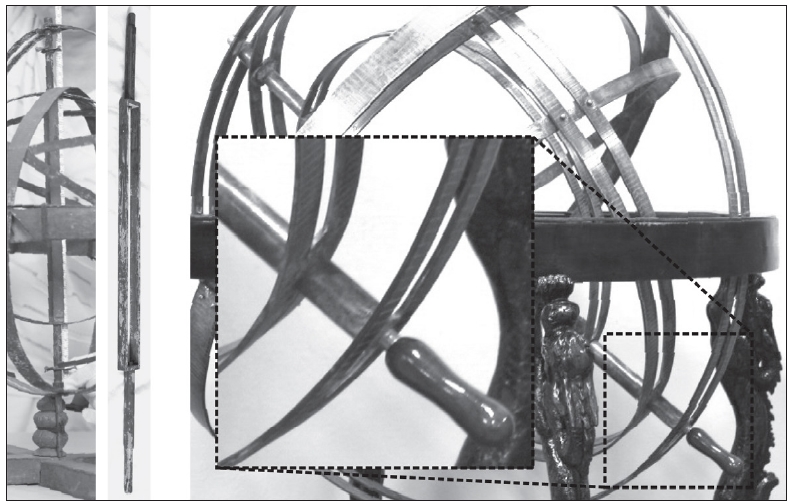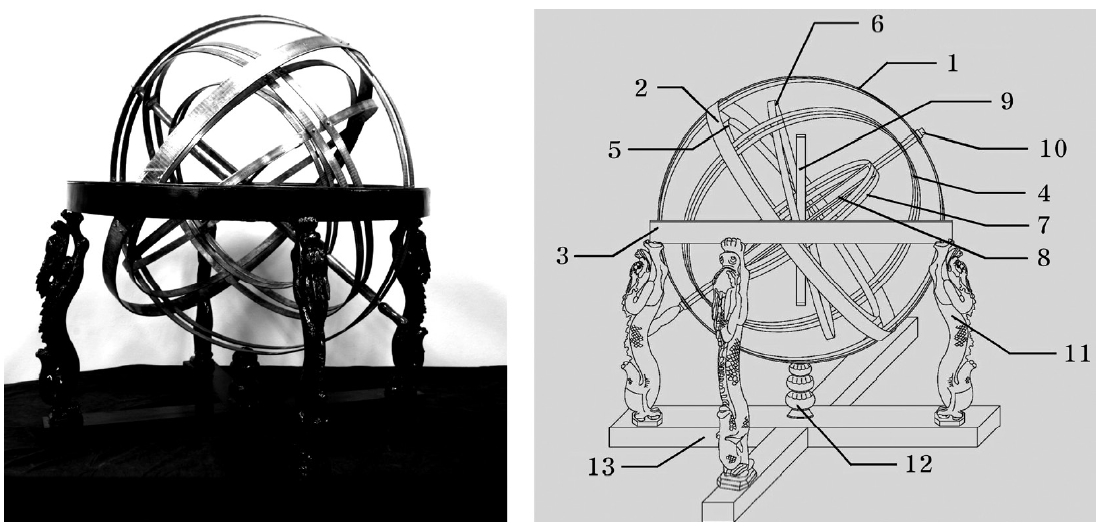The armillary sphere was a traditional astronomical instrument in East Asia designed to measure the location of celestial bodies. As such, it has the function to measure time and seasons. The armillary sphere, whose shape was crafted on the "egg-like hypothesis (Honcheonseol)", surrounds the celestial sphere in a circle from the observer's perspectives. The structure of an armillary sphere allows the user to observe the location of celestial bodies on the celestial sphere by the equatorial coordinates system centered on the North Pole, and also to estimate the location of the horizontal coordinates system and the ecliptic coordinates system through the horizontal ring and the ecliptic ring. The rotation axis of the armillary sphere has the same structure as that of the equatorial coordinates system in modern astronomy, and it is in the same direction of the sky's North Pole. It can excellently measure the Ipsudo (similar to right ascension value) of the equatorial coordinates system and Geogeukdo (similar to declination value), as well as makes it convenient to observe and understand the movement of celestial bodies on the celestial sphere. The basic structure of the armillary sphere consists of three-layer rings. The outer layer consists of Yukhapui (fixed outer terrestrial-coordinate component); the middle layer, Samsinui (revolving sidereal component); the inner layer, Sayuui.
The armillary sphere was not only an instrument designed to observe the astronomical phenomena, but also an instrument designed to symbolize the monarchical authority and embody the monarchical politics on the basis of Confucian ideologies (Lee et al. 2001). Joseon's kings, who embraced the duty of observing astronomical phenomena and identifying the time and providing the information to the people, manufactured diverse armillary spheres and Honcheonsigye (armillary clock),which have not nearly survived to present day. Joseon's well-reputed Confucian scholars manufactured armillary spheres.
Among armillary spheres which were used by Toegye Lee Hwang (1501~1570), Uam Song Si-Yeol (1607~1689), Goedam Bae Sang-Yeol (1759~1789) and etc, some of their components or some damaged instruments are extant.One of the Four Books (Saseo) and Three Classics (Samgyeong), the Class of History, which was a must-read book for Confucian scholars, says that King Shun (Chinese leader) crafted Seongiokhyeong (armillary sphere), an astronomical instrument, to observe the sun, the moon, and the five planets. Scholars trained in the way of nature by performing astronomical observation with armillary spheres, and Confucian scholars, who aimed to achieve the unification of the heaven and man, studied the rise and fall of the sun, the moon and five planets so as to pursue the study of things and nature, the basis of studies.
Confucian scholars attached importance to astronomical observation because they believed that all ways, the most fundamental principle of Confucianism, come from the heaven. In particular, it was important Confucian thought that kings and bureaucrats should know the will of the heaven and accordingly rule the people. Also, the armillary sphere was considered an important instrument to allow Confucian scholars to know and understand what would happen in the heaven as well as the principle of how that would happen on the basis of one of basic Confucian principles, respecting the people’s will and following the will of the heaven.
However, some extant armillary spheres dating back to the Joseon period have suffered damage; their components are damaged and their rings are misplaced and damaged. In this study, the components of extant armillary spheres used by Toegye, Uam, and Goedam were measured and analyzed, and their design drawings were crafted in order to restore these relics, and thus Toegye's and Uam's armillary spheres were restored.
Scientific investigations were leaded to restore the operating models of armillary spheres used by Confucian scholars. Extant relics were measured, damaged parts were analyzed, and the size and structures of extant armillary spheres were investigated. Table 1 shows the results of scientific investigations into the extant armillary spheres used by Toegye, Goedam, and Uam.
The armillary sphere of Toegye (hereinafter Toegye armillary sphere) is on display at Okjingak (Okjingak pavilion)of Dosanseowon (Dosan Confucian Academy) near Andong-si, Gyeongsangbuk-do. Some components of armillary sphere, namely, components of various rings along with Honsang (celestial globe) are exhibited there. Their shapes and structures are hard to figure out, but Goedam Bae Sang-Yeol observed the armillary sphere on display there and crafted one in 1779 (Jeong et al. 2007).
The armillary sphere of Goedam (hereinafter Goedam armillary sphere), as mentioned earlier, after visiting Dosanseowon, Goedam observed the Toegye armillary sphere and crafted one. Our measurement and investigations of the Goedam armillary sphere revealed that all of its components were made of wood (Table 1). The pole of polar axis which is basic drive shaft, the Gyuhyeong(sighting alidade) which is a surveying device and the Ounju (turtle pillar) that supports the center of the armillary sphere were lost and only some components have been left as damaged. Various rings, some of which were lost, are tied in a bundle.
This armillary sphere has the same structure as that of an ordinary armillary sphere, except that its Jeokdodanhwan(revolving equator single ring) is wide, and that traditional Korean paper, attached inside the Jeokdodanhwan, features the pictures and names of 28 constellations.This distinguishes it from other armillary spheres, allowing it to easily explain the method of observing celestial bodies. Fig. 1 shows the extant Goedam armillary sphere. Actual measurements and characteristics of each component are outlined in Table 2. In particular, 23 characters are engraved at the bottom of the Sipjabachim (cross support). These letters are written "it was first crafted in the year of Gihae (1779, at the age of 21 years), and it was renovated in the year of Eulsa (1785, at the age of 27 years) but was not elaborately crafted because of the poor material and inadequate skills; thus, it should be renovated again using better techniques and better wood."
The armillary sphere of Uam (hereinafter Uam armillary sphere) was used by Song Si-Yeol for teach his students while he was residing in Hwayang-dong after leaving the political circles. It is now kept by Cheongju National Museum after it was well preserved by his descendants. According to his descendant, Mr. Song Yeong-Dal1, it could be preserved because it was buried under the ground during the Korean War. The frame of this armillary sphere which is made of wood and tied with strings is remain but various metal rings are either lost or corroded or partly damaged or misplaced (See Table 1 and Fig. 2). 24 directions were engraved on outer side of wooden horizontal
ring and also each direction divided into two specific directions for closer direction measurement so wooden horizontal ring shows 48 directions.
Its various metal rings each feature carvings of accurate scale marks. Its wooden Yongju (dragon pillar) emblems and sculptures are the most artistic of the extant armillary spheres. Lee (2007) revealed that the Uam armillary sphere was used not for actual observation but for educational purpose. His literary quotation says, "The teacher (Uam) says that it is difficult to understand
with pictures alone. It is not difficult to know if one attempts to examine the reason for crafting the device". He also revealed that the Uam armillary sphere was crafted by Lee Min-Cheol (1631~1715). Lee Min-Cheol crafted a water-operated armillary sphere in 1669 (10th year of the reign of King Hyeonjong), and was the then best expert on armillary spheres. He was well versed in astronomical instruments, calendar and sciences. Uam, while serving as a governor in 1680 (the 6th year of the reign of King Sukjong), gave a detailed explanation on the principle of solar eclipse to the king in a feast.2 Uam also gave the explanation on the principle of Honcheonsigye (armillary clock) crafted by Lee Min-Cheol during the reign of King Sukjong.
1When the writer visited him to his residence at Cheongju-si, he showed the Uam armillary sphere to the writer, and mentioned so in 1997.
2Changgyejip, a Collection of Literary Works, vol. 18: 17ab; Gyeongyeonnok
Design drawings were crafted on the basis of the actual measurement of the various components of Toegye, Goedam and Uam armillary sphere. Table 2 shows a comparison of the specifications and characteristics between the Toegye3, Goedam and Uam armillary sphere and the astronomical clock and armillary sphere crafted by Song I-Yeong (1619~1674) (Kim 2007). Song I-Yeong's armillary sphere is linked to the alarm clock of the astronomical clock, now National Treasure No. 230, which was manufactured at the 10th year of reign of King Hyeonjong (1669),
and it is a key extant device crafted by a national agency (Lee & Kim 2007). This armillary sphere is sized similar to that of private armillary spheres, and it is a standard with which to compare extant Joseon armillary spheres.
Historical records that in the 18th century sayGoedam Bae Sang-Yeolsaw the Toegye armillary sphere at Dosanseowon and crafted an armillary sphere.4 Based on these records, the basic design drawings of the Toegye armillary sphere was crafted by referring to the Goedam armillary sphere. The Sipjabachim (cross support) and Yongju of the Goedam armillary sphere are well preserved to identify the structure of an armillary sphere. Thus, these were measured, and the various remaining rings of the Toegye armillary sphere were also measured; thus, an armillary sphere was designed and restored as in Fig. 3.
Based on the measurement and analysis of the Goedam armillary sphere (Fig. 4-left), a structural drawing and restoration design drawings were completed. Fig. 4-right
shows a structural drawing to identify the structure and component names of the Goedam armillary structure, and this drawing denotes the name of each component. Fig. 5 shows part of the restoration design drawing.
We restored Uam armillary sphere as an actual working model through a minute analysis regarding original one. The horizontal ring, Yongju and Ounju of restored one are retain its original form and the scale marks and characters are etched on each restored bronze Jeokdodanhwan and Hwangdodanhwan.
The 28 orient traditional constellations (Su) are arranged from East to West on outer side of Jeokdodanhwan which shows the movement celestial bodies from East to West. These 28 orient traditional constellations are arranged as follows: Jinsu → Ikusu → Jangsu → Seongsu → Ryusu → Gwisu → Jeongsu → Samsu → Jasu → Pilsu →Myosu → Wisu → Nusu → Gyusu → Byeoksu → Silsu → Wisu → Heosu → Yeosu → Usu → Dusu → Gisu → Misu → Simsu → Bangsu → Jeosu → Hangsu → Gaksu. The interval of these 28 constellations is not consistent, but their total angle is 365.25 degrees.
Hwangdodanhwan is sun’s annual path on the celestial globe and it decline 24 degrees than Jeokdodanhwan. The 24 divisions of the year (Jeolgi) arranged from East to West on outer side of Hwangdodanhwan like as Jeokdodanhwan.These 24 divisions of the year are arranged as follows: Dongji (winter solstice) → Sohan → Daehan → Ipchun→ Usoo → Gyeongcheop → Chunbun (spring equinox) → Cheongmyeong → Goku → Ipha → Soman → Mangjong → Haji (summer solstice ) → Soseo → Daeseo → Ipha → Cheoseo → Baengno → Chubun (autumn equinox) → Hallo → Sanggang→ Soseol → Daeseol.
The Uam armillary sphere's polar axis, namely, Jikgeo, spreads symmetrically from the center to both south and north; the lower end is long and pointed (Fig. 6-left). It is deemed that the pointed part, as the handle, was taken and used to rotate the polar axis(Fig. 6-right). This rotation handle of the South Pole cannot be discovered in any other extant armillary spheres.5 All components including this were manufactured and the operating model of the Uam armillary sphere was restored. Fig. 7 shows a
structural drawing which features the names of its various components along with the restored shape.
3Extant Toegye armillary sphere components were measured, and the Goedam armillary sphere crafted on the basis of the Toegye armilary sphere was examined, so as to determine the whole measurement of the armillary sphere.
4This Honsang, which has thus far been known to be that of Toegye, was identified as that of Goedam, according to the recording on the inside. Also, details on Goedam armillary sphere are presented.
5The catalogue of exhibits displayed at the special exhibition at Japan's Osaka Museum, 1999, October 6-11, presents extant armillary spheres dating back to the second half of Edo. The armillary sphere has a two-level gear at the south, and a handle designed to manually rotate the gear. This is structurally similar to the extant armillary sphere kept by Soongsil University Korean Christian Museum, and it is deemed to have developed from the Uam armillary's polar axis rotation system.
6Kim Seong-il (1538~1593), A Serial of Hakbong's Collection of Literary Works, vol. 5.
Toegye, Goedam and Uam armillary sphere have significant historic value even their bad state of preservation.
Most of Confucian scholars during Joseon era made their own armillary spheres personally and used them as a study-aid tool for studying the principle of nature. The Toegye armillary sphere is a case in point, it was manufactured by his disciple Ganjae Lee Deok-Hong (1541~1596), and the Memoir on Toegye6 says, "The master (Toegye) allowed his students to play the game of throwing arrows into a jar in a bid to observe their virtuous personality. He also ordered Deok-Hong to craft Seongiokhyeong and observe astronomical phenomena (Lee 2006)." Lee Deok-Hong was the most competent Confucian scholar among Toegye's disciples; however, unfortunately, only a few components of the precious armillary atmospheres used by him have survived to present day, making it impossible to accurately identify their structures and shapes. Fortunately, in this study, the Toegye armillary sphere was able to be restored by investigating and estimating the structure of Goedam armillary sphere which was crafted on the basis of the Toegye armillary sphere.
The National Treasure No. 230, armillary sphere of Song I-yeong Honcheonsigye which was installed at Hongmungwan(Office of Special Advisors) after it was manufactured by Gwansanggam (Bureau of Astronomy), is Joseon's key armillary sphere. Table 2 shows a comparative analysis of the characteristics of extant Toegye, Goedam, Uam, and Song I-Yeong armillary spheres.
Of the four armillary spheres, the Goedam armillary sphere is the largest, and it used unique-color wood components unlike other armillary spheres. Its various rings' Jucheondo (circumference of celestial globe) scale marks are expressed every 10 degrees so as to allow a fast and convenient measurement of angles. Its various rings' colors and materials were used according to functions and names. Also it contains Baekdodanhwan unlike other private armillary spheres. Although some of its components have lost and been damaged, it is equipped with all components that could be seen in the traditional Seongiokhyeongdo (armillary sphere chart) depicted in Seojeon.
In particular, characteristically, 28 constellations are depicted on the equatorial ring. The 28 constellation’s names and charts are useful in performing astronomical observation or offering education on astronomy, and this feature cannot be discovered in other extant East Asian armillary spheres. Also, our scientific investigations revealed that the manufacturing year, the manufacturer and the manufacturing backgrounds were inscribed on the floor of the wood Sipjabachim of the armillary sphere.
The extant Uam armillary sphere is partially damaged; some of its components are misplaced and some other components are lost. However, its structure consists of wood frames and metal rings, making it particular. The metal rings, which strongly cover the wood Jipyeonghwan, feature 24 directions and scale marks. Various metal rings are not only well formed, but also feature accurate scale mark carvings.
In the process of restoring the Uam armillary sphere, the rotation handle of the polar axis was manufactured. Various rings were deigned to be driven not by hand but by operating the rotation axis. This structure cannot be discovered in other extant armillary spheres. In particular,the Uam armillary sphere is the only extant relic that was manufactured by Lee Min-Cheol, the then best craftsman of armillary spheres; it is all the more valuable.
When we restore Korean traditional scientific and technological heritages with highly acclaimed creativity which are long forgotten, we can newly understand the scientific spirit of our forefathers. Also, by restoring armillary spheres used by Confucian scholars, we had an opportunity to understand the thoughts on nature and science and cosmological view of our well-reputed scholars who sought to explore the skies and natural phenomena.
12 Si 12時, twelve double-hours; Myo 卯: hare (a.m. 5~7), Yu 酉: cock (p.m. 5~7), etc.
24 Jeolgi 節氣, 24 divisions of the year; These 24 divisions of the year are arranged as follows: Dongji 冬至, Sohan 小寒, Daehan 大寒, Ipchun 立春, Usoo 雨水, Gyeongcheop 驚蟄, Chunbun 春分, Cheongmyeong 淸明, Goku 穀雨, Ipha 立夏, Soman 小滿, Mangjong 芒種, Haji 夏至, Soseo 小署, Daeseo 大暑, Ipha 立秋, Cheoseo 處暑, Baengno 白露, Chubun 秋分, Hallo 寒露, Sanggang 霜降, Soseol 小雪, Daeseol 大雪
28 Su 宿, 28 constellations; Gaksu 角宿, Hangsu 亢宿, Jeosu ?宿, Bangsu 房宿, Simsu 心宿, Misu 尾宿, Gisu 箕宿, Dusu 斗宿, Usu 牛宿, Yeosu, 女宿, Heosu 虛宿, Wisu 危宿, Silsu 室宿, Byeoksu 壁宿, Gyusu 奎宿, Nusu 婁宿, Wisu 胃宿, Myosu 昴宿, Pilsu 畢宿, Jasu ?宿, Samsu 參宿, Jeongsu 井宿, Gwisu 鬼宿, Ryusu 柳宿, Seongsu 星宿, Jangsu 張宿, Ikusu 翼宿, Jinsu 軫宿
Baekdodanhwan 白道單環, moon-path single ring
Cheongyeongheukssanghwan 天經黑雙環, meridian double ring
Cheonwijeokdanhwan 天緯赤單環, fixed equator single ring
Dosanseowon 陶山書院, Dosan Confucian Academy
Ganjae Lee Deok-Hong 艮齋 李德弘(1514~1596)
Geogeukdo 去極度, similar to declination value of the equatorial coordinates system
Goedam Bae Sang-Yeol 槐潭 拜相說(1759~1789)
Gwansanggam 觀象監, Bureau of Astronomy
Gyuhyeong 窺衡, sighting alidade
Heoncheonseol 渾天說, Enveloping Heaven Theory
Honcheonseol 渾天說
Honcheonsigye 渾天時計, armillary clock
Honcheonui 渾天儀, armillary sphere
Hongmungwan 弘文館, Office of Special Advisors
Honsang 渾象, celestial globe
Hwan 環, ring
Hwangdodanhwan 黃道單環, ecliptic single ring
Hyeonjong 顯宗, King Hyeonjong of Joseon (1641-1674)
Ipsudo 入宿度, similar to right ascension value of the equatorial coordinates system
Jeokdodanhwan 赤道單環, revolving equator single ring
Jikgeo 直距
Jipyeonghwan 地平環, fixed outer terrestrial-horizon single ring
Jucheondo 周天度, 365.2575度
Jucheondo 周天度, circumference of celestial globe, 365.2575度
Lee Min-Cheol 李敏哲(1631~1715)
Okjingak 玉振閣, Okjingak pavilion
Ounju 鰲雲柱, turtle pillar
Samgyeong 三經, Three Classics (詩經, 書經, 周易)
Samsinheukssanghwan 三辰黑雙環, solstitial-colure double ring
Samsinui 三辰儀, revolving sidereal component
Saseo 四書, Four Books (論語, 孟子, 中庸, 大學)
Sayussanghwan 四遊雙環, mobile declination double ring
Sayuui 四遊儀
Seojeon 書傳
Seongiokhyeong 璇璣玉衡, armillary sphere
Seongiokhyeongdo 璇璣玉衡圖, armillary sphere chart
Shun 舜, Chinese leader
Sipjabachim 十字받침, cross prop
Song I-Yeong 宋以?(1619~1674)
Toegye Lee Hwang 退溪 李滉(1501~1570)
Uam Song Si-Yeol 尤庵 宋時烈(1607~1689)
Yongju 龍柱, dragon pillar
Yukhapui 六合義, fixed outer terrestrial-coordinate component




